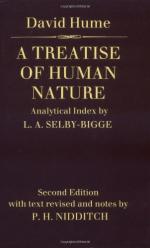Perhaps these four reflections may help to remove an difficulties to the hypothesis I have proposed concerning abstract ideas, so contrary to that, which has hitherto prevailed in philosophy, But, to tell the truth I place my chief confidence in what I have already proved concerning the impossibility of general ideas, according to the common method of explaining them. We must certainly seek some new system on this head, and there plainly is none beside what I have proposed. If ideas be particular in their nature, and at the same time finite in their number, it is only by custom they can become general in their representation, and contain an infinite number of other ideas under them.
Before I leave this subject I shall employ the same principles to explain that distinction of reason, which is so much talked of, and is so little understood, in the schools. Of this kind is the distinction betwixt figure and the body figured; motion and the body moved. The difficulty of explaining this distinction arises from the principle above explained, that all ideas, which are different, are separable. For it follows from thence, that if the figure be different from the body, their ideas must be separable as well as distinguishable: if they be not different, their ideas can neither be separable nor distinguishable. What then is meant by a distinction of reason, since it implies neither a difference nor separation.
To remove this difficulty we must have recourse to the foregoing explication of abstract ideas. It is certain that the mind would never have dreamed of distinguishing a figure from the body figured, as being in reality neither distinguishable, nor different, nor separable; did it not observe, that even in this simplicity there might be contained many different resemblances and relations. Thus when a globe of white marble is presented, we receive only the impression of a white colour disposed in a certain form, nor are we able to separate and distinguish the colour from the form. But observing afterwards a globe of black marble and a cube of white, and comparing them with our former object, we find two separate resemblances, in what formerly seemed, and really is, perfectly inseparable. After a little more practice of this kind, we begin to distinguish the figure from the colour by a distinction of reason; that is, we




